This practical book provides an end-to-end guide to TensorFlow, the leading open source software library that helps you build and train neural networks for deep learning, Natural Language Processing (NLP), speech recognition, and general predictive analytics. The book provides a hands-on approach to TensorFlow fundamentals for a broad technical audience—from data scientists and engineers to students and researchers. The authors begin by working through some basic examples in TensorFlow before diving deeper into topics such as CNN, RNN, LSTM, and GNN. The book is written for those who want to build powerful, robust, and accurate predictive models with the power of TensorFlow, combined with other open source Python libraries. The authors demonstrate TensorFlow projects on Single Board Computers (SBCs).
